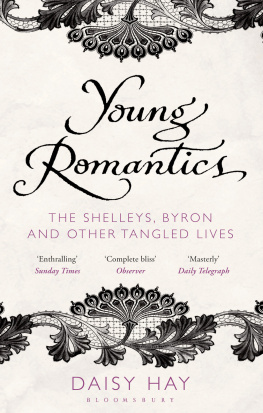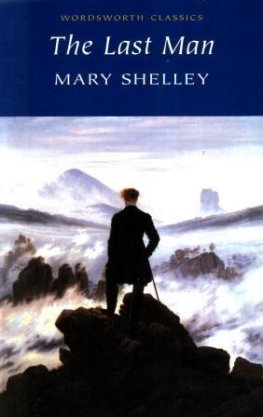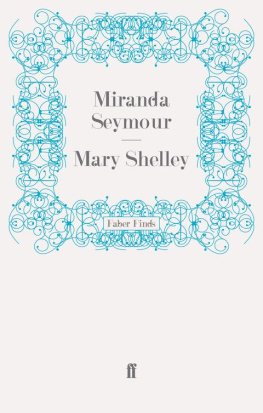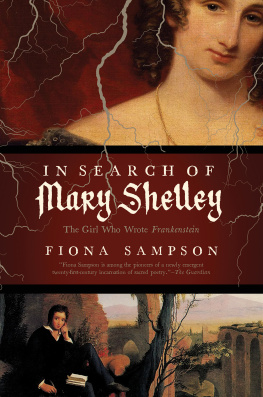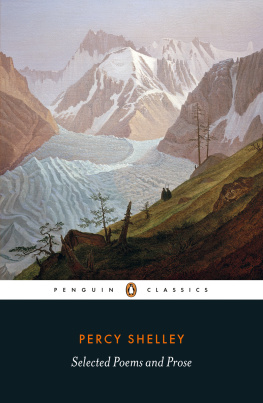Anyone currently working on the Romantic writers explored in this book owes a substantial debt of gratitude to the biographers and literary critics who have revolutionised the study of Romantic lives and letters over the past few decades. I would like to acknowledge the inspiration I have drawn from biographies of Shelley by Richard Holmes and James Bieri; of Mary Shelley by Emily Sunstein and Miranda Seymour; and of Leigh Hunt by Nicholas Roe. I have been influenced by several key studies of Romantic sociability, chief among them Marilyn Butlers Romantics, Rebels and Reactionaries , Jack Stillingers Multiple Authorship and the Myth of the Solitary Genius , Charles Robinsons Shelley and Byron: The Snake and Eagle Wreathed in Fight , and Jeffrey Coxs Poetry and Politics in the Cockney School .
I am also indebted to those who have undertaken the Herculean task of editing Romantic letters and diaries. I particularly wish to acknowledge Betty T. Bennetts volumes of Mary Shelleys letters; Marion Kingston Stockings editions of Claire Clairmonts letters and diaries; and the Pforzheimer Collections Shelley and his Circle volumes, edited by Kenneth Neill Cameron, Donald Reiman, Doucet Fischer and others. I am most grateful to Timothy Webb, who shared with me some of the findings relating to his forthcoming edition of Leigh Hunts Autobiography and to David Cheney, whose work on a complete edition of Hunts correspondence ceased only with his death. I have made substantial use of Dr Cheneys typescript and thank the University of Toledo for allowing me access to his papers, and his widow, Pat Cheney, for making me welcome during my visit to Ohio.
Throughout my research on the Shelleys and the Hunts I have been fortunate to be able to draw on the support and advice of many individuals. In Cambridge Leo Mellor, Raphael Lyne and Heather Glen have provided much encouragement, and I am very grateful to the President and Fellows of New Hall for awarding me a Bye-Fellowship to support my work. I am also grateful to Nigel Leask, who supervised my doctoral thesis on literary collaboration in the Shelley circle. My agent, Clare Alexander, has been a wonderful advocate and a source of much wisdom, and Michael Fishwick at Bloomsbury and Paul Elie at Farrar, Straus and Giroux have been generous and incisive editors. It has been a pleasure to work with Margaret Stead, who copy-edited the book, and Anna Simpson, who saw it through production.
For help with particular questions I would like to thank Bruce Barker-Benfield, Peter Cochran, Nicholas Roe, Michael Rossington, William St Clair and Heather Tilley. I would also like to record my gratitude to the late Marion Kingston Stocking, who answered several questions about the papers of Claire Clairmont, and to Candia McWilliam, who very kindly scrutinsed a set of proofs. In archives and libraries I have been aided by Sid Huttner, Nana Diederichs, Kathy Flynn, Isaac Gewirtz, Elizabeth Denlinger and Charles Carter, as well as by the staff of the Brotherton Collection, Leeds, the British Library, the London Library, the Bodleian Library, and Cambridge University Library. I owe special thanks to Paul Howard, for his translations of the manuscript letters of Alexander Mavrocordato, and to Barbara Floyd and Sandra Rice, for the warm welcome they extended to me during my stint at the University of Toledos Canaday Centre. Jessie and Johnny Saunders, Jane Deuser, and Liz and Matthew Edwards were all wonderfully hospitable during my travels to archives in Britain and the United States. Doucet Fischer has guided me at every stage as I have attempted to unravel the complexities of the Pforzheimer Collection manuscripts, and has done so with unflagging wit and good humour. Above all I am indebted to Nora Crook, who has read the book in draft, saved me from my own inaccuracies on numerous occasions, and who, over the past few years, has generously revealed to me the fathomless depths of her knowledge of all things Shelleyan. All mistakes are, of course, my own.
I could not have written this book without the support of my friends and my family, and am very grateful to them all for listening. In particular, I thank Polly Mackenzie and Aoife N Luanaigh for their advice; my sister, Marianna Hay, for her support; and my father, Michael Hay, for his unwavering faith in my abilities and for much quiet good sense along the way. I have discussed this book at every stage of its development with my mother, Amanda Mackenzie Stuart, and feel exceptionally fortunate to have been able to draw on her expertise as I have put my narrative together. Most of all, I would like to thank my husband, Matthew Santer, who has lived with the Romantics for as long as he has lived with me. He has accompanied me on fact-finding missions in England and Italy, has read drafts and been the source of many sensible suggestions and, on one notable occasion, sat beside me in an archive in Salem, Massachusetts, searching near-illegible nineteenth-century notebooks for references to Shelley, as we raced the clock towards closing time. I cannot thank him enough for his support.
For permission to quote from manuscript material, I am grateful to the following institutions: the Bodleian Library, Oxford; the Peabody Essex Museum, Salem, Mass.; the Luther Brewer Leigh Hunt Collection at the University of Iowa; and, at the New York Public Library, the Pforzheimer Collection of Shelley and his Circle and the Henry W. and Albert A. Berg Collection of English and American Literature. I also gratefully acknowledge the support of the London Library Trust, provided through the award of Carlyle Membership of the library.
This book has a large cast of characters, some of whom share surnames, and several of whom share first names. Applying consistent naming conventions therefore presents certain practical and ideological challenges. In order to overcome these I have used the names most frequently used by the group themselves. Throughout, Percy Bysshe Shelley is referred to as Shelley, the name used by his mistress and his friends from 1814 onwards. Mary Wollstonecraft Shelley is referred to as Mary, the name by which she was universally known. More generally, following the conventions adopted in the groups letters and diaries, men are referred to by their surnames and women by their Christian names. In certain isolated cases the group themselves do not conform to this convention, and in these instances I have adopted their most frequently used alternatives.
The original spelling and punctuation of manuscript material has been retained, and mistakes and inconsistencies have been left uncorrected and unmarked by [ sic ], unless otherwise stated. Quotations from published primary sources follow the editorial conventions of particular volumes, which in most cases refrain from silent correction.
On 3 February, 1813, Leigh Hunt began a two year prison sentence at Surrey Gaol in Horsemonger Lane, London. His crime was libel; his victim the Prince Regent. It was, by any standards, a harsh punishment, but Leigh Hunt was determined to bear imprisonment and separation from his family with fortitude. I must feel like a brother, a father and a husband, but I can still act like a man, he wrote. I have friends above price; I have done my duty; I am an Englishman setting an example to my children and my country; and it would be hard, under all these circumstances, if I could not suffer any extremity rather than disgrace myself by effeminate lamentation or worse compromise.
Surrey Gaol was nestled among the narrow streets of modern-day Southwark. It was one of the largest prisons in England and, like other county gaols, held a mixture of common criminals and debtors, who lived in and around the prison with their families. Its governor, Mr Ives, ran his establishment as a flourishing business, charging prisoners fees for ale, the services of prostitutes, the removal of chains, and even for release on acquittal by a court. Visitors formed an essential part of the prison economy, bringing the incarcerated food and money to pay fees as well as small home comforts bedding, warm clothes which made life inside more bearable.
Next page
